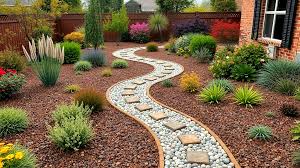With droughts becoming more frequent and water conservation increasingly essential, creating a water-wise landscape is a practical way to maintain a beautiful yard that also reduces water use. Drought-resistant landscaping focuses on smart design, efficient watering methods, and plant choices that thrive in drier conditions. Here’s a guide to help you establish a sustainable, water-wise yard that’s both stunning and environmentally friendly. For more information check out landscaping company in dubai
1. Plan with Purpose: Design a Drought-Resistant Layout
Thoughtful planning is crucial for water-wise landscaping. Start by assessing your yard’s sunlight exposure, soil type, and natural slopes, as these factors influence water retention and plant placement. Consider zoning your yard into “hydrozones” — grouping plants with similar water requirements together. Place thirsty plants in areas with better water access, such as near downspouts or shaded zones, and keep drought-tolerant plants in sun-drenched areas that dry out more quickly.
Incorporate hardscape features like gravel, stones, and pathways to minimize the need for water-hungry lawns and to add visual interest. Hardscapes don’t just conserve water; they also reduce maintenance and bring texture and structure to your landscape design.
2. Choose Native and Drought-Resistant Plants
Native plants are adapted to your local climate and are naturally more resilient during dry spells. Drought-resistant plants, like succulents, lavender, and ornamental grasses, also thrive in low-water environments. Some popular choices include:
- Succulents and Cacti: These plants store water in their leaves and come in various shapes and colors, making them versatile and decorative.
- Ornamental Grasses: Varieties like blue fescue, fountain grass, and feather reed grass are drought-tolerant and provide texture.
- Herbs: Lavender, sage, rosemary, and thyme are aromatic, low-maintenance options that also add beauty and utility.
For ground cover, consider drought-resistant options like creeping thyme or blue star creeper instead of traditional grass. These plants reduce the need for irrigation while providing lush, green coverage.
3. Optimize Soil Health and Water Retention
Soil that retains moisture reduces the need for frequent watering. Improve your soil’s water-holding capacity by adding organic matter, such as compost or well-aged manure, to enhance its texture and nutrient levels. Mulching around plants is also essential; it conserves moisture, reduces evaporation, and prevents soil erosion.
Organic mulch, such as wood chips or shredded bark, helps keep the soil cool and moist. For even more water retention, consider using water-storing crystals in your soil mix. These crystals can absorb and release water over time, keeping plants hydrated for longer periods.
4. Replace or Reduce Traditional Lawns
Traditional grass lawns are often the most water-intensive feature in a yard. Consider replacing high-maintenance grass with drought-tolerant alternatives like buffalo grass, Bermuda grass, or a mix of native ground covers. For a lush look without the water demands, install a mix of low-growing ground covers, clover, or artificial turf.
If a grass lawn is essential, consider creating smaller lawn areas and leaving the rest of your yard to drought-tolerant plants, gravel, or mulch. This reduces your overall water use and makes for a more sustainable landscape.
5. Use Efficient Irrigation Techniques
Traditional sprinklers often lead to water waste through evaporation and runoff. Instead, switch to efficient irrigation systems, such as drip irrigation or soaker hoses, which deliver water directly to the plant roots. Drip irrigation reduces water loss, minimizes runoff, and targets water where plants need it most, promoting deeper root growth.
For lawns or larger plant zones, consider installing a smart irrigation controller. These devices adjust watering schedules based on weather conditions, preventing over-watering and conserving water during rainy periods. Watering early in the morning or late in the evening also reduces evaporation, ensuring plants absorb the most water.
6. Practice Deep and Infrequent Watering
Over-watering can encourage shallow roots, making plants less resilient to drought. Instead, water deeply and infrequently, allowing the soil to dry out between watering sessions. Deep watering encourages roots to grow deeper into the soil, increasing their access to moisture during dry spells.
To determine when it’s time to water, check the soil moisture level. Insert a finger a couple of inches into the soil — if it feels dry, it’s time to water. For established drought-tolerant plants, watering once every few weeks may be sufficient.
7. Add Rainwater Harvesting Systems
Harvesting rainwater is an eco-friendly way to capture and store water for your landscape. Install rain barrels under downspouts to collect water runoff from your roof, which you can use during dry periods to water plants. A single rain barrel can save up to 1,300 gallons of water over the growing season.
For more extensive rainwater collection, consider installing a cistern system to store larger amounts of water. Rainwater is free of the chemicals often found in municipal water and can provide a healthier water source for your garden.
8. Incorporate Mulching for Water Conservation
Mulch is a water-wise gardener’s best friend, as it helps retain moisture, regulates soil temperature, and suppresses weed growth. Apply a 2-3 inch layer of organic mulch around plants and throughout garden beds to prevent water evaporation. This keeps the soil moist and reduces the need for frequent watering.
Organic mulches, such as shredded bark, wood chips, and straw, also break down over time, adding nutrients to the soil. Rock or gravel mulch can work well in drier areas, especially around succulents and cacti, but be mindful of heat buildup from stones, as this can stress certain plants in extreme temperatures.
9. Add Shade to Reduce Evaporation
Shade helps reduce evaporation, keeping plants cooler and reducing water needs. Consider adding shade trees, pergolas, or trellises with climbing vines to shield delicate plants from direct sunlight. Larger plants can act as shade “umbrellas” for smaller plants beneath them, creating a natural, layered garden structure that conserves water.
Incorporate shade structures strategically, allowing sun-loving, drought-tolerant plants to bask in the sunlight, while more sensitive plants get relief in shaded areas. Shade elements also add visual interest and diversity to your landscape design.
10. Consider Xeriscaping for an Ultra-Low-Water Landscape
Xeriscaping is a landscaping approach focused on minimal water use, often using a mix of native and drought-tolerant plants, gravel, and hardscape features. With xeriscaping, you can create a stunning, eco-friendly yard that requires very little water or maintenance. Succulents, ornamental grasses, and Mediterranean herbs like lavender and rosemary are popular choices in xeriscapes.
In xeriscaping, bare soil is often covered with a layer of gravel or mulch to reduce evaporation. You can create interesting focal points with rock formations or decorative boulders, making xeriscapes visually appealing and unique. This approach is ideal for arid climates or anyone looking to create a low-maintenance, water-efficient landscape.
Enjoying a Beautiful, Sustainable Yard
Water-wise landscaping doesn’t mean sacrificing beauty or functionality. By planning a drought-resistant landscape that uses efficient irrigation, native plants, and water-conserving practices, you’ll enjoy a yard that thrives even during dry spells. Not only does this approach save water and reduce maintenance, but it also creates a sustainable outdoor environment that benefits both you and the planet.
Keep an eye for more news & updates on Discover Tribune!



